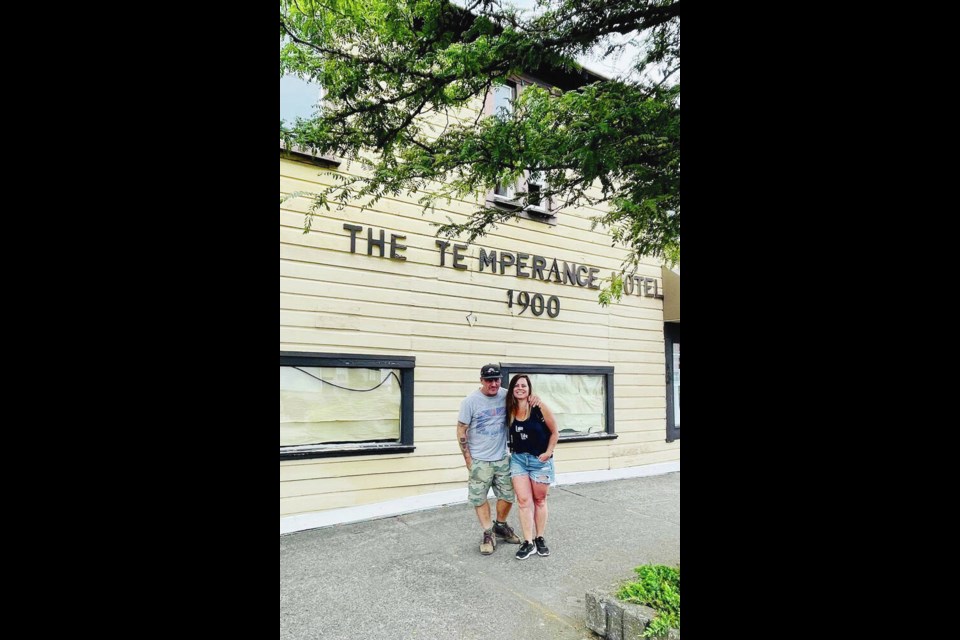It was once home to alcohol-abstaining coal miners and served as an isolation hospital during the Spanish Flu outbreak more than a century ago.
Now Ladysmith’s 121-year-old Temperance Hotel is getting a new lease on life as a rental apartment with some Airbnb-style vacation suites.
The historic hotel on the town’s main street is being completely renovated, rewired and plumbed, its foundation lifted and rebuilt, in a full-bore restoration.
New owners Stefan Queitsch and Denise Bergquist, who bought the property a year ago, have been rolling up their sleeves and doing much of the work themselves, with structural help from Kaercher Projects and Construction of Victoria.
They want to bring the Temperance into the modern age as rental suites, a few of them Airbnb-style for the town’s growing tourism sector and for visiting sailors.
Ironically, one option for the ground floor of the Temperance is a new brew pub, but the new owners are exploring all options for commercial tenants.
Queitsch, a plumber who co-owns Scorpion Mechanical, and Bergquist, who works with Island Health, are not afraid of hard work.
They’ve been labouring on the hotel evenings and weekends — and it hasn’t been an easy job.
“We were pulling down the ceilings — the rat droppings were as thick as the insulation,” said Bergquist. “As we go deeper [into the reno], we’re finding all kinds of new problems.”
The last renovation of the building was in the early 1950s.
Since it was built in 1900, the Temperance has been continuously occupied, as a hotel, a rooming house — some say even a brothel — as the local branch of the Royal Canadian Legion, and most recently as low-income apartments.
Various commercial clients have come and gone, from ice cream shops to doctors’ offices, but it’s been in a state of disrepair for decades. Lately, it’s attracted drug users and criminal activity.
“It’s got a bad rap over the years … we want to give it a new life, some persona,” said Bergquist. “We get people walking by every day, saying thank you. We want to give the building another 100 years.”
The modest two-storey, wood-frame building in Ladysmith’s commercial core is recognized by the federal and local governments as a heritage property, and the owners plan to maintain its exterior appearance. They found one of the hotel’s original colours — a shade of blue — beneath several layers of paint, and the exterior colour will be replicated. The original sign will be repainted on the exterior.
They’re also matching the original windows, but leaving much of the exterior exactly as it was in accordance with heritage standards.
The couple hopes to open with eight new suites in the spring.
The Temperance Hotel has played a significant role in the history of the area. Built in nearby Wellington at the height of coal Baron Robert Dunsmuir’s empire, the building was cut into sections as Dunsmuir extended the coal seam, then loaded onto flat cars and moved by rail to Ladysmith as the town was developed.
Like most mining communities, early Ladysmith had a large population of single, often transient, men. Hotels functioned as living quarters and their ground-floor saloons and restaurant often served as social centres.
In that sense, the Temperance was a rarity, as the only local hotel that did not serve alcohol. It’s an enduring symbol of the temperance movement, considered one of the most important social movements of the nineteenth and early twentieth centuries.
Quentin Goodbody, president of the Ladysmith Historical Society, said the Temperance Hotel stood out as a non-drinking establishment. “The demon drink was often a hardship for families, because a paycheque could go down a father’s gullet” instead of putting food on the table, he said.
The hotel was built and operated by the Uren family. According to the historical society, Mrs. Uren “wasn’t so big, but she was a real fireball,” and would only accept miners as boarders “because they bathed every day.”
“The actual coal miners were the cleanest people that she had ever known,” according to comments archived with the historical society. “They bathed every day. And they never came into the building with dirty clothes on. Always washed and dressed.”
The second floor had single rooms, while the ground floor contained the Uren family’s living quarters, a dining room and another area for travelling salesmen to display their wares. A washhouse for miners was at the back of the building.
The hotel played a central role during the Great Strike of 1912-1914, because it accommodated single men brought in by Dunsmuir as strike breakers. As such, it became a focal point for the frustrations of strikers during 1913 riots, and the target of one of two bombs ignited on the night of Aug. 12.
The strikers ultimately failed in their efforts to achieve better wages, working conditions and union recognition, and returned to work.
During the influenza epidemic of 1918-19, as wards of the Ladysmith hospital were overflowing, the Temperance spread mattresses on the floor for sick patients. At least 24 people in Ladysmith died from the Spanish Flu.
Goodbody said several other hotels were moved to Ladysmith from Wellington around 1900 — the current Ladysmith Inn and Sportsman Pub on First Avenue (previously known as the New Western Hotel); the Jones Hotel on Gatacre Street; and the Bayview Apartments (previously known as the Extension Hotel and Globe Hotel) now on the Trans-sa国际传媒 Highway.



